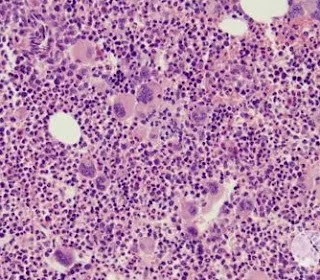Chronic Myeloproliferative Neoplasms (MPN)-Polycythemia
Polycythemia It is an abnormally increased concentration of hemoglobin in the blood, either through reduction of plasma volume or increase in red cell numbers.
People with polycythemia have an increase in hematocrit levels >50% in men or >45% in women, hemoglobin is >16.5 g/dL in women or >18.5 g/dL in men or red blood cell count above the normal limits.
Classification:
A. Absolute
1. Primary Polycythemia
• Happen when too many red blood cells are produced due to abnormal bone marrow.
• Often, excess white blood cells and platelets are also produced.
- Polycythemia (Rubra) vera
- Familial (congenital) Polycythemia.
2. Secondary Polycythemia
Caused by compensatory erythropoietin increase in:
- High altitudes
- Pulmonary disease and alveolar hypoventilation (sleep apnea)
- Cardiovascular disease, especially congenital with cyanosis.
- Increased affinity hemoglobin (familial Polycythemia).
- Heavy cigarette smoking
- Tumors (such as uterine leiomyoma, renal cell carcinoma, and hepatocellular carcinoma).
B. Relative Polycythemia (Stress or Pseudopolycythemia):
• It is the increase in the number of RBCs while the total RBC quality has not increased.
• Usually, this is caused by the loss of plasma volume and the resulting blood concentration, as shown below:
a. Dehydration: water deprivation, vomiting.
b. Plasma loss: burns, enteropathy.
Polycythemia Rubra Vera (PV)
• It is a slowly developing blood cancer. There are too many red blood cells in the bone marrow, which may also lead to too many other types of blood cells (white blood cells and platelets).
• The JAK2 gene guides the production of proteins that promote cell growth and division (proliferation).
• This protein is called the JAK/STAT pathway can transmit chemical signals from outside the cell to the nucleus.
• JAK2 protein is important for control from Hematopoietic stem cells.
• These stem cells are found in the bone marrow and may develop into red blood cells, white blood cells, and platelets.
Etiology
• The problem with blood cell production associated with polycythemia vera is caused by a change, or mutation, to DNA in a single cell in the bone marrow.
This mutation is a change in a protein switch that tells cells to grow. Specifically, it is a mutation of the protein JAK2 (JAK2 V617F mutation).
More than 90% of patients with polycythemia vera and about half of patients with other myeloproliferative diseases have this mutation.
Risk Factors
• Age-polycythemia vera is more common in adults and people over 60 years of age. Rarely seen in people under 20
• Gender-polycythemia affects men more than a woman
• Family history-in some cases, polycythemia vera seems to be a member of the family, which shows heredity factors other than JAK2 may also cause the disease.
Clinical Features:
In its early stages, polycythemia vera usually doesn't cause any signs or symptoms. As the disease progresses, the following symptoms may be experienced:
1. Headache
2. Dizziness
3. Itching, especially after a hot bath or shower
4. Redness of the skin and plethoric face
5. Shortness of breath
6. Breathing difficulty when the patient is lying supine
7. Numbness, tingling, burning, or weakness in hands, feet, arms, or legs
8. Chest pain
9. Enlarged spleen causes a feeling of fullness or bloating in the upper left abdomen
10.Fatigue
• Bleeding complications, seen in approximately 1% of patients with PV, include epistaxis, gum bleeding, ecchymoses, and gastrointestinal (GI) bleeding.
Thrombotic complications (1%) include venous thrombosis or thromboembolism and an increased prevalence of stroke and other arterial thromboses.
• Abdominal pain due to Peptic Ulcer Disease maybe present because PV is associated with increased histamine levels and gastric acidity.
• Elevated histamine levels cause itching released from basophils and mast cells, a warm bath or shower will exacerbate this situation.
Diagnosis
CBC
1. The number of red blood cells increases, and in some cases the number of platelets or white blood cells increases.
2. Elevated hematocrit measurement and Elevated levels of hemoglobin.
Other Laboratory Investigations
1. The oxygen level in the blood is lower than normal.
2. Polymerase chain reaction: JAK2 mutation
3. Serum Erythropoietin assay: are often below the lower limit of normal.
4. Leukocyte alkaline phosphatase distinguishes PV from CML.
Bone marrow aspiration or biopsy
• Examination of bone marrow shows that it's producing higher than normal amounts of blood cells, which may be a sign of polycythemia vera.
If an individual has polycythemia vera, analysis of their bone marrow or blood may also reveal disease-related DNA changes (JAK2 V617F mutation).
Treatment:
Treatment focuses on reducing the number of blood cells to control signs and symptoms of the disease and decrease the risk of complications.
1. Phlebotomy
For most people with polycythemia vera, this is usually the first treatment option.
This reduces the number of blood cells and reduces the volume of blood, making it easier for blood to function normally.
The frequency with which a patient needs phlebotomy depends on the severity of your condition.
2. Medication to decrease blood cells.
Blood draw alone may not be enough to control the signs, symptoms, and complications of polycythemia vera in some people.
If this is the case, drugs such as hydroxyurea or anagrelide can be used to inhibit the bone marrow's ability to produce blood cells.
Radioactive phosphorus (32p) can also be used to reduce the number of red blood cells.
Interferon-α also used to stimulate the immune system to fight the excessive production of red blood cells.
3.Low-dose aspirin.
Aspirin reduces the risk of blood clots. Small doses of aspirin may also help reduce burning pain in the feet or hands.
4. Therapy to reduce itching.
Antihistamines or H-2-receptor blockers, or ultraviolet treatment can relieve discomfort.
Second-line therapy for PV
Ruxolitinib (Jakafi), a JAK1/JAK2 inhibitor, for treatment of patients with polycythemia vera who have had an inadequate response to or are intolerant of hydroxyurea.





Comments
Post a Comment